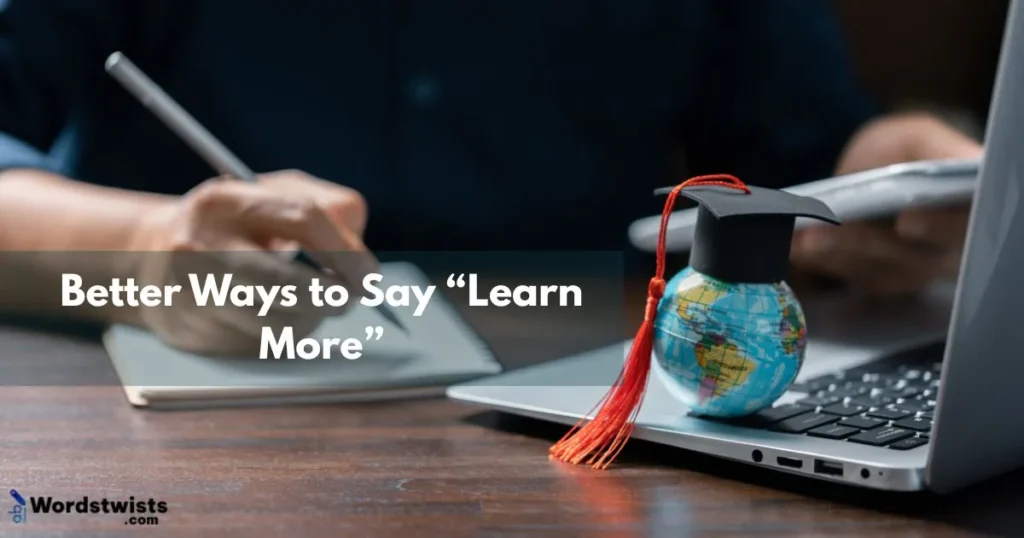Let’s be honest — the phrase “Learn More” is everywhere. You see it on websites, ads, and emails so often that it’s easy to scroll past without a second thought. It’s simple, but let’s face it — it’s overused and a little dull.
If you want your writing or call-to-action (CTA) to actually stand out, you need more expressive and engaging alternatives. The right word can spark curiosity, boost click-through rates, and make your message sound like it came from a real person — not a template.
In this guide, I’ll share 25 creative alternatives to “Learn More” that add energy and personality to your writing. Each option includes examples, meanings, and tips on when to use it so your communication skills and copywriting tone feel more polished and natural.
Ready? Let’s jump into some fresh and human ways to say “Learn More.”
Best Alternatives to “Learn More”
1. Discover
Meaning & Use
“Discover” is perfect when you want to spark curiosity or help readers feel like they’re about to uncover something valuable or new. It works beautifully in blogs, landing pages, and product descriptions.
Examples
- Discover how small changes can grow your business fast.
- Discover the secret behind our smooth skincare formula.
- Discover new ways to boost your productivity.
- Discover what makes this plan perfect for beginners.
- Discover your next favorite weekend activity.
Why It Works
“Discover” feels active and exciting. It turns learning into a mini adventure and makes readers feel they’re finding something special.
2. Explore
Meaning & Use
“Explore” gives off a sense of adventure and curiosity. It’s ideal for websites or emails that invite people to browse collections, features, or stories.
Examples
- Explore our complete range of eco-friendly products.
- Explore new ideas to make your workflow smoother.
- Explore what others are saying about our service.
- Explore how this course can boost your skills.
- Explore your options and find what fits you best.
Why It Works
“Explore” feels open and inviting. It encourages readers to click without pressure — just pure curiosity.
3. Find Out
Meaning & Use
“Find Out” feels friendly and conversational. It works well for everyday readers who want quick answers or solutions.
Examples
- Find out what makes this deal so popular.
- Find out how to improve your sleep in one week.
- Find out what our customers really think.
- Find out which plan works best for you.
- Find out how easy it is to get started today.
Why It Works
It sounds natural and personal — like a friend inviting you to see something interesting, not a sales pitch.
4. Get the Details
Meaning & Use
“Get the Details” is great for clear, informative CTAs — perfect for events, offers, or products where you want to sound transparent and trustworthy.
Examples
- Get the details about our latest offer.
- Get the details before you make your choice.
- Get the details and see why users love it.
- Get the details about our upcoming webinar.
- Get the details and compare your options.
Why It Works
It sounds simple and honest — great for readers who want facts before they act.
5. See How It Works
Meaning & Use
This phrase is practical and visual. It fits best for demos, tutorials, or explainer content where you want users to understand a process.
Examples
- See how it works in three easy steps.
- See how our platform saves you time.
- See how this routine transforms your skin.
- See how it fits perfectly into your workflow.
- See how others are getting real results.
Why It Works
It promises clarity and helps people visualize success before they commit.
6. Check It Out
Meaning & Use
“Check it out” is casual, friendly, and works best when your tone is relaxed or playful. It’s great for blogs, social posts, and informal marketing.
Examples
- Check it out — our latest guide is now live.
- Check it out before this offer ends.
- Check it out and see why everyone’s talking about it.
- Check it out for quick tips that actually work.
- Check it out — you’ll love what we’ve added.
Why It Works
It feels personal and spontaneous, like a genuine recommendation from a friend rather than a brand slogan.
7. Dive In
Meaning & Use
“Dive in” gives energy and encourages action. It’s perfect for online courses, tutorials, or anything where readers are invited to start right away.
Examples
- Dive in and start learning today.
- Dive in to explore the full story.
- Dive in and see what makes this so powerful.
- Dive in — your next big idea starts here.
- Dive in and experience the change yourself.
Why It Works
It has momentum. “Dive in” feels bold, confident, and exciting — perfect for motivational CTAs or creative content.
Read More: Other Ways to Say “For Example In An Essay” (With Examples)
8. Uncover
Meaning & Use
“Uncover” has a mysterious and intriguing tone. It’s ideal for articles, campaigns, or ads where you want readers to feel like they’re revealing something hidden.
Examples
- Uncover the truth behind common myths.
- Uncover why this strategy really works.
- Uncover the best-kept secret in marketing.
- Uncover hidden features you might’ve missed.
- Uncover how small changes make a big impact.
Why It Works
“Uncover” feels like solving a puzzle — it awakens curiosity and keeps readers interested in what’s next.
9. See More
Meaning & Use
Short and simple, “See More” is perfect for visual or product-based content like image galleries, product listings, or creative portfolios.
Examples
- See more styles from our new winter collection.
- See more results from real customers.
- See more photos of the event.
- See more ways to use this tool.
- See more before you decide.
Why It Works
It’s clear, direct, and visually oriented, making it a great fit for audiences who like quick previews.
10. Take a Look
Meaning & Use
“Take a look” has a warm, personal touch. It’s inviting and easygoing — good for both professional and casual tones.
Examples
- Take a look at our latest updates.
- Take a look before making your decision.
- Take a look — you might be surprised.
- Take a look at what others are saying.
- Take a look inside to see the difference.
Why It Works
It sounds conversational and polite — like friendly encouragement rather than a demand to click.
11. Read On
Meaning & Use
“Read on” fits perfectly in blogs, guides, or storytelling content. It invites people to continue reading without breaking the flow.
Examples
- Read on to find out what happened next.
- Read on to learn how this method actually works.
- Read on and see the results for yourself.
- Read on for expert-backed insights.
- Read on — you’ll be glad you did.
Why It Works
It’s smooth and natural, helping you maintain engagement within long-form content.
12. Keep Reading
Meaning & Use
“Keep reading” is friendly and straightforward — ideal for blog posts or email newsletters that guide the reader down the page.
Examples
- Keep reading to uncover the secret behind this tip.
- Keep reading for a step-by-step breakdown.
- Keep reading — it gets better from here.
- Keep reading to learn what makes this effective.
- Keep reading for real-life examples you can try.
Why It Works
It adds a personal voice that feels like a writer talking directly to the reader.
13. Go Deeper
Meaning & Use
“Go deeper” signals insight and expertise. It’s excellent for educational, technical, or analytical writing.
Examples
- Go deeper into the data that proves it works.
- Go deeper and understand the real reason behind it.
- Go deeper to explore the science.
- Go deeper into expert-level strategies.
- Go deeper and see what most people miss.
Why It Works
It appeals to readers who want depth and understanding, not just surface-level info.
14. Get Started
Meaning & Use
“Get started” is action-driven. It works best for sign-ups, free trials, or courses — anything that helps readers take the first step.
Examples
- Get started with your free trial today.
- Get started and see instant results.
- Get started — it’s easier than you think.
- Get started with just one click.
- Get started and make today productive.
Why It Works
It’s motivating and empowering — it pushes readers toward taking action now.
15. Learn How
Meaning & Use
“Learn how” is simple and informative, great for educational content or tutorials where you promise value and clarity.
Examples
- Learn how to manage your time like a pro.
- Learn how to start a small business from scratch.
- Learn how this strategy can double your traffic.
- Learn how others achieved similar results.
- Learn how to make your writing more persuasive.
Why It Works
It’s a classic phrase that promises knowledge and transformation in one line.
16. Step Inside
Meaning & Use
“Step inside” feels inviting and immersive. It’s perfect for websites, landing pages, or digital tours where you want readers to experience your brand or content.
Examples
- Step inside and see how it all works.
- Step inside our world of design and creativity.
- Step inside to discover exclusive content.
- Step inside and find out what makes us different.
- Step inside — your journey starts here.
Why It Works
It makes readers feel personally included. The phrase adds warmth and creates a sense of experience, not just information.
17. Find More
Meaning & Use
“Find more” is perfect when you’re offering additional information, related posts, or extra resources. It’s clean, simple, and user-friendly.
Examples
- Find more tips to improve your workflow.
- Find more ideas in our full guide.
- Find more ways to save money this season.
- Find more stories from our community.
- Find more helpful tools right here.
Why It Works
It’s short and clear. Readers know exactly what they’ll get — useful extra value.
18. Get the Full Story
Meaning & Use
This phrase is perfect for blogs, storytelling, or brand content. It invites readers to learn the background or deeper meaning behind something.
Examples
- Get the full story behind this idea.
- Get the full story and see how it started.
- Get the full story about our journey.
- Get the full story from industry experts.
- Get the full story before making your choice.
Why It Works
It’s emotional and relatable — it connects with the reader’s natural curiosity and desire for context.
19. Take the Tour
Meaning & Use
“Take the tour” fits well for digital tools, apps, or websites that want to walk new visitors through features or benefits.
Examples
- Take the tour and see how it works.
- Take the tour before you sign up.
- Take the tour to explore our new dashboard.
- Take the tour and find your favorite tools.
- Take the tour — it only takes a minute.
Why It Works
It’s clear and interactive. It gives users a sense of control and discovery while staying helpful.
20. Have a Look
Meaning & Use
“Have a look” is relaxed, friendly, and fits conversational or informal writing. It works great in blogs, personal brands, or community-driven content.
Examples
- Have a look at what’s trending now.
- Have a look and tell us what you think.
- Have a look inside our creative process.
- Have a look — it might surprise you.
- Have a look at our latest updates.
Why It Works
It’s conversational and easy to connect with. It sounds like a real person inviting you in — not a business pitch.
21. Get Insights
Meaning & Use
“Get insights” suits professional or educational settings. It’s best when your content offers data, analysis, or expert opinion.
Examples
- Get insights from top industry leaders.
- Get insights that help you make smarter decisions.
- Get insights into what’s changing this year.
- Get insights from the experts you trust.
- Get insights that move your business forward.
Why It Works
It positions your content as valuable and credible, making readers feel they’re learning from real expertise.
22. See for Yourself
Meaning & Use
“See for yourself” builds trust. It’s excellent for testimonials, product demos, and case studies where you want proof to speak louder than claims.
Examples
- See for yourself how easy it is to use.
- See for yourself what customers are saying.
- See for yourself — the results are real.
- See for yourself how this approach saves time.
- See for yourself why people love it.
Why It Works
It encourages firsthand experience and feels honest — perfect for skeptical or curious audiences.
23. Start Exploring
Meaning & Use
A friendly mix of curiosity and action, “Start exploring” works best for resource hubs, galleries, and knowledge bases.
Examples
- Start exploring our full collection.
- Start exploring and find what inspires you.
- Start exploring new ways to stay organized.
- Start exploring to see what fits your needs.
- Start exploring and uncover hidden gems.
Why It Works
It combines energy and curiosity — a gentle nudge for readers to take the next step.
24. Unlock
Meaning & Use
“Unlock” has a strong emotional pull. It’s powerful in marketing, coaching, or self-improvement content where transformation is the goal.
Examples
- Unlock your full creative potential.
- Unlock access to exclusive tips and guides.
- Unlock the secret to stress-free mornings.
- Unlock success with proven strategies.
- Unlock what’s been holding you back.
Why It Works
It creates a feeling of reward and empowerment — like the reader is gaining something special.
25. Learn the Secret
Meaning & Use
“Learn the secret” is catchy and great for storytelling, marketing hooks, or tips-based content. It teases value without giving everything away.
Examples
- Learn the secret to writing headlines that convert.
- Learn the secret behind lasting motivation.
- Learn the secret to smooth skin in just minutes.
- Learn the secret every top performer knows.
- Learn the secret to better sleep tonight.
Why It Works
It taps into natural curiosity. Readers want to know what others don’t — it’s persuasive and engaging without sounding forced.
Final Thoughts
Overusing “Learn More” can make your writing sound repetitive and uninspired. The good news is, these 25 creative alternatives give you a wide range of tones — from friendly and casual to confident and professional. Whether you’re writing for a website, social post, or marketing campaign, choosing the right phrase adds clarity, character, and warmth to your message.
Try mixing these into your copy, experiment with what fits your brand, and you’ll see your engagement, readability, and conversion instantly improve.
If you found this guide helpful, start exploring your favorite alternatives today — because words don’t just inform, they inspire.

I’m Leo Knox, the wordplay wizard behind WordsTwists.com where I turn everyday meanings into funny, clever, and creative twists. If you’re tired of saying things the boring way, I’ve got a better (and funnier) one for you!


